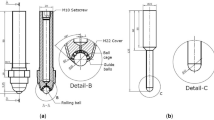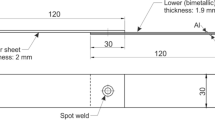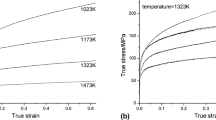Abstract
The recent advance of the single-point incremental forming (SPIF) was possible by flexibility with used the Computer Numeric Control (CNC) machine and increase manufacture. The objective of this study is to investigate correlation between the limit angle, work-hardening, stress coefficient, and thickness in two alloys, an aluminum EN AW-1100 and magnesium AZ31-B. For this study, tests were on aluminum and magnesium plates with thickness 1 mm for stamping of cones, with a roller ball tool for conditions, spindle speeds 0 RPM, feed rate 1500 mm/min, and increment 0.01 mm/rot. The study points to a phenomenon with few observations so far, which is adhesion at the tip of the tool and influences the fracture in the material. The experimental results show that an adhesion is an indicator of premature fracture in the material, and favors the conformation of the material the increase of strength coefficient, and the reduction of the strain-hardening exponent of the hooloning equation favors the conformation of the material.










Similar content being viewed by others
References
Durante M, Formisano A, Lambiase F (2018) Incremental forming of polycarbonate sheets. J Mater Process Technol 253:57–63. https://doi.org/10.1016/j.jmatprotec.2017.11.005
Zha GC, Shi XF, Zhao W, Gao L, Wu ML (2016) Experimental research of incremental sheet forming based on fastened pre-tensioning. Int J Adv Manuf Technol 82:711–717. https://doi.org/10.1007/s00170-015-7411-9
Jeswieta J, Micarib F, Hirtc G, Bramleyc A, Dufloue JA (2005) Asymmetric single point incremental forming of sheet metal. CIRP Ann 54:88–114
Duflou JR, Behera AK, Vanhove H, Bertol LS (2013) Manufacture of accurate titanium cranio-facial implants with high forming angle using single point incremental forming. Key Eng Mater 549:223–230. https://doi.org/10.4028/www.scientific.net/kem.549.223
Mirnia MJ, Shamsari M (2017) Numerical prediction of failure in single point incremental forming using a phenomenological ductile fracture criterion. J Mater Process Technol 244:17–43. https://doi.org/10.1016/j.jmatprotec.2017.01.029
Henry SD, Davidson GM, Lampman SR, Reidenbach F, Boring RL, Scott WW Jr (1996) Fatigue data book: light structural alloys. ASM Int 33:33–5731. https://doi.org/10.5860/choice.33-5731
Song L, Wu B, Zhang L, du X, Wang Y, Esling C (2018) Twinning characterization of fiber-textured AZ31-B magnesium alloy during tensile deformation. Mater Sci Eng A 710:57–65. https://doi.org/10.1016/j.msea.2017.10.055
Min J, Kuhlenkötter B, Shu C, Störkle D, Thyssen L (2018) Experimental and numerical investigation on incremental sheet forming with flexible ort from metallic foam. J Manuf Process 31:605–612. https://doi.org/10.1016/j.jmapro.2017.12.013
Bagudanch I, Lozano-Sánchez LM, Puigpinós L, Sabater M, Elizalde LE, Elías-Zúñiga A, Garcia-Romeu ML (2015) Manufacturing of polymeric biocompatible cranial geometry by single point incremental forming. Procedia Eng 132:267–273. https://doi.org/10.1016/j.proeng.2015.12.494
Lu H, Kearney M, Li Y, Liu S, Daniel WJT, Meehan PA (2016) Model predictive control of incremental sheet forming for geometric accuracy improvement. Int J Adv Manuf Technol 82:1781–1794. https://doi.org/10.1007/s00170-015-7431-5
Gatea S, Ou H, McCartney G (2016) Review on the influence of process parameters in incremental sheet forming. Int J Adv Manuf Technol 87:479–499. https://doi.org/10.1007/s00170-016-8426-6
Hussain G, Gao L, Hayat N, Cui Z, Pang YC, Dar NU (2007) Tool and lubrication for negative incremental forming of a. J Mater Process Technol 3:193–201. https://doi.org/10.1016/j.jmatprotec.2007.10.043
Diabb J, Rodríguez CA, Mamidi N, Sandoval JA, Taha-Tijerina J, Martínez-Romero O, Elías-Zúñiga A (2017) Study of lubrication and wear in single point incremental sheet forming (SPIF) process using vegetable oil nanolubricants. Wear 376–377:777–785. https://doi.org/10.1016/j.wear.2017.01.045
Patel A, Guo H, Iglesias P (2018) Study of the lubricating ability of protic ionic liquid on an aluminum-steel contact. Lubricants 6. https://doi.org/10.3390/lubricants6030066
Dakhli M, Boulila A, Tourki Z (2017) Effect of generatrix profile on single-point incremental forming parameters. Int J Adv Manuf Technol 93:2505–2516. https://doi.org/10.1007/s00170-017-0598-1
Hussain G, Gao L (2007) A novel method to test the thinning limits of sheet metals in negative incremental forming. Int J Mach Tools Manuf 47:419–435. https://doi.org/10.1016/j.ijmachtools.2006.06.015
Bai L, Yang M, Cui F et al (2018) Study on thickness thinning ratio of the forming parts in single point incremental forming process. Adv Mater Sci Eng 2018:1–11. https://doi.org/10.1155/2018/2927189
McAnulty T, Jeswiet J, Doolan M (2017) Formability in single point incremental forming: a comparative analysis of the state of the art. CIRP J Manuf Sci Technol 16:43–54. https://doi.org/10.1016/j.cirpj.2016.07.003
Kumar A, Gulati V (2018) Experimental investigations and optimization of forming force in incremental sheet forming. Sadhana 43:43. https://doi.org/10.1007/s12046-018-0926-7
Dong C, Sun J, Cheng Z, Hou Y (2019) Preparation and tribological properties of a microemulsion for magnesium alloy warm rolling. Ind Lubr Tribol 71:74–82. https://doi.org/10.1108/ILT-06-2018-0222
Acknowledgments
The authors would like to thank the institutions PUC-MG, CNPQ, FAPEMIG for the support and encouragement of technological research.
Author information
Authors and Affiliations
Corresponding author
Additional information
Publisher’s note
Springer Nature remains neutral with regard to jurisdictional claims in published maps and institutional affiliations.
Rights and permissions
About this article
Cite this article
de Castro Maciel, D., da Silva, G.C. & de Quadros, L.M. Incremental stamping forming with use of roller ball tool in aluminum and magnesium alloy. Int J Adv Manuf Technol 108, 455–462 (2020). https://doi.org/10.1007/s00170-020-05425-4
Received:
Accepted:
Published:
Issue Date:
DOI: https://doi.org/10.1007/s00170-020-05425-4




